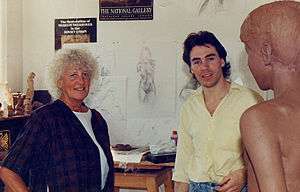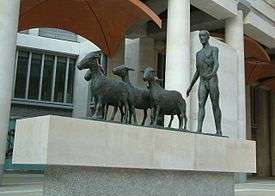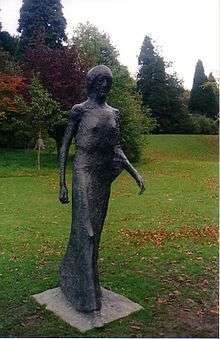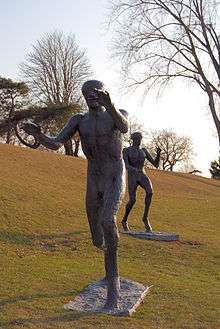Elisabeth Frink
| Dame Elisabeth Frink CH DBE RA | |
|---|---|
 Dame Elisabeth Frink and John McKenna | |
| Born |
November 14, 1930 Great Thurlow, Suffolk, England |
| Died |
April 18, 1993 (aged 62) Blandford Forum, Dorset, England |
| Alma mater |
Guildford School of Art Chelsea School of Art |
| Known for | Sculpture |
Dame Elisabeth Jean Frink CH DBE RA (14 November 1930 – 18 April 1993) was an English sculptor and printmaker. Her Times obituary noted the three essential themes in her work as the nature of Man; the "horseness" of horses; and the divine in human form.[1]
Early life
Elisabeth Frink was born in November 1930 at her paternal grandparents home The Grange in Great Thurlow, a village and civil parish in the St Edmundsbury district of Suffolk, England. Her parents were Ralph Cuyler Frink and Jean Elisabeth (née Conway-Gordon). Captain Ralph Cuyler Frink, was a career officer in the 4th/7th Royal Dragoon Guards and among the men of the cavalry regiment evacuated from Dunkirk in the early summer of 1940.
The Second World War, which broke out shortly before Frink's ninth birthday, provided context for some of her earliest artistic works. Growing up near a military airfield in Suffolk, she heard bombers returning from their internecine missions and on one occasion was forced to hide under a hedge to avoid the machine gun attack of a German fighter plane. Her early drawings, from the period before she attended arts school in London, have a powerful apocalyptic flavour: themes include wounded birds and falling men.[2] During the course of the war Frink was evacuated with her mother and brother Tim to Exmouth, Devon where she attended Southlands Church of England School. When Southlands School was commandeered for the war effort in 1943 Frink became a full time pupil at The Convent of the Holy Family School.
Career
Frink studied at the Guildford School of Art (now the University for the Creative Arts) (1946–1949), under Willi Soukop, and at the Chelsea School of Art (1949–1953). She was part of a postwar group of British sculptors, dubbed the Geometry of Fear school, that included Reg Butler, Bernard Meadows, Kenneth Armitage and Eduardo Paolozzi. Frink’s subject matter included men, birds, dogs, horses and religious motifs, but very seldom any female forms. Bird (1952; London, Tate), one of a number of bird sculptures, and her first successful pieces (also Three Heads and the Figurative Tradition) with its alert, menacing stance, characterizes her early work.



Although she made many drawings and prints, she is best known for her bronze outdoor sculpture, which has a distinctive cut and worked surface. This is created by her adding plaster to an armature, which she then worked back into with a chisel and surform. This process contradicts the very essence of "modeling form" established in the modeling tradition and defined by Rodin's handling of clay.
In the 1960s Frink’s continuing fascination with the human form was evident in a series of falling figures and winged men. While living in France from 1967 to 1970, she began a series of threatening, monumental male heads, known as the goggled heads. On returning to England, she focused on the male nude, barrel-chested, with mask-like features, attenuated limbs and a pitted surface, for example Running Man (1976; Pittsburgh, PA, Carnegie Mus. A.). Frink’s sculpture, and her lithographs and etchings created as book illustrations, drew on archetypes expressing masculine strength, struggle and aggression.
The 1980s held capstones for Frink's career. In 1982, a new publishing firm proposed to produce a catalogue raisonné of all of her works to date; and the Royal Academy planned a retrospective of her life's work. The date of the retrospective, originally to be held in 1986, was moved forward a year due to space demands at the gallery, causing Frink some headaches due to her busy commissioned work schedule. In 1985 alone, she was committed to two major projects: a set of three figures for a corporate headquarters, one of which was a nearly 7-foot-tall (2.1 m) male nude; and the other, a grouping entitled Dorset Martyrs for Dorchester, Dorset.
However, despite the potential for conflict, the retrospective was a success and spurred the art world to hold more exhibitions of Frink's worth, with four solo exhibitions and several group ones coming in the following year. Tirelessly, Frink continued to accept commissions and sculpt, as well as serve on advisory committees, meet art students who had expressed an interest in her work, and pursue other public commitments.
The landowners and art collectors Michael Pitt-Rivers and William Gronow-Davis were friends.[3]
Frink kept up this hectic pace of sculpting and exhibiting until early 1991, when an operation for cancer of the oesophagus caused an enforced break. However, short weeks later Frink was again creating sculptures and preparing for solo exhibitions. In September, she underwent further surgery. Again, Frink did not let this hold her back, proceeding with a planned trip for exhibitions to New Orleans, Louisiana, and New York City. The exhibitions were a success, but Frink's health was clearly deteriorating. Despite this, she was working on a colossal statue, Risen Christ, for Liverpool Cathedral. This sculpture would prove to be her last; just one week after its installation, Frink died from cancer on 18 April 1993, aged 62, in Blandford Forum, Dorset. Stephen Gardiner, Frink's official biographer, argued that this final sculpture was appropriate: "This awesome work, beautiful, clear and commanding, a vivid mirror-image of the artist's mind and spirit, created against fearful odds, was a perfect memorial for a remarkable great individual."[4]
Personal
Frink married Michel Jammet in 1955: their son was born in 1958 and the marriage was dissolved in 1963.[2] Between 1964 and 1974 she was married to Edward Pool.[2] Hungarian born Alexander Csaky, whom she married as her third husband in 1974, predeceased her by only a few months.[2]
Highlights
Warhorse and Walking Madonna may be seen in the garden at Chatsworth House. Other work is at the Jerwood Sculpture Park at Ragley Hall. Uniquely in England, Desert Quartet (1990), Frink's penultimate sculpture, was given Grade II* listing in 2007, less than 30 years from its creation by the Department for Culture, Media and Sport.[5] It may be seen opposite Liverpool Gardens in Worthing.
Frink School of Figurative Sculpture
Before Frink died in 1993, she had given master classes at the Sir Henry Doulton School of Sculpture then headed by sculptor Colin Melborne ARA in Stoke-on-Trent, England. Rosemary Barnett took over as principal of the Sir Henry Doulton School of Sculpture, Stoke-on-Trent, briefly before its closure. In 1990 she met Harry Everington there and their shared artistic outlook brought about the Frink School of Figurative Sculpture which opened in 1996 in Longton and closed in 2005 at Tunstall.
Permission from the Frink Estate was given to name a new school after her, because it was to continue the tradition which she represented. The Frink School of Figurative Sculpture opened in 1996, with an emphasis on sculptural form; it attempted to give some balance to the declining figurative training and increased conceptualism in sculpture schools in the UK.
Cultural reference
Frink was one of five 'Women of Achievement' selected for a set of British stamps issued in August 1996. The others were Dorothy Hodgkin (scientist), Margot Fonteyn (ballerina / choreographer), Marea Hartman (sports administrator) and Daphne Du Maurier (writer). Works by Frink are held in the collections of the Jerwood Gallery, National Galleries of Scotland, The Ingram Collection of Modern British and Contemporary Art, The Priseman Seabrook Collection and the Victoria and Albert Museum.
Frink was chosen as the subject of the British Art Medal Society medal in 1992. The medal by Avril Vaughan was featured in the Society's journal, The Medal, no 23 (1993).[6] The medal was cast by the Royal Mint in an edition of 47 medals.[7]
Frink's sculptures were featured in the 1963 science fiction film The Damned, directed by Joseph Losey. Frink not only lent these but also was on location for their shooting and coached actor Viveca Lindfors on performing the sculptor’s method of building up plaster, which was then ferociously worked and carved.
See also
- Bust of Sir Georg Solti, Chicago
References
- ↑ Dame Elisabeth Frink; Obituary, The Times, 20 Apr 1993
- 1 2 3 4 Bryan Robertson (18 April 1993). "Obituary: Dame Elisabeth Frink". The Independent, London. Retrieved 15 April 2017.
- ↑ UK, Dukes Auctions, Dorchester, Dorset,. "Duke's to sell the collection of the late William Gronow Davis MFH". Dukes Auctions. Retrieved 23 December 2017.
William Gronow Davis was the lifelong partner of the late Michael Pitt-Rivers. <snip> Both William and Michael were great patrons of the arts and friends included Dame Elisabeth Frink, whose work is well represented in this collection.
- ↑ Gardiner 1998, p. 282
- ↑ "Archived copy". Archived from the original on 2 December 2008. Retrieved 19 November 2008.
- ↑ "British Medal Art Society | The Medal (issue 23, Autumn 1993)". www.bams.org.uk. Retrieved 2018-05-15.
- ↑ "British Medal Art Society | Elisabeth Frink". www.bams.org.uk. Retrieved 2018-05-15.
Biography and sources
- Stephen Gardiner, 1998, Elisabeth Frink: The Official Biography. Harper Collins Publishers. ISBN 0-00-255606-5
- Elisabeth Frink: catalogue raisonné. Sculpture to 1984. Foreword by Peter Shaffer. Introduction and Dialogue by Bryan Robertson. Published by Harpvale Books. ISBN 0-946425-05-1
- Edward Lucie-Smith. Elisabeth Frink: catalogue raisonné. Sculpture since 1984 & Drawings. Published by Art Books International. ISBN 1-874044-04-X
- Caroline Wiseman. Elisabeth Frink: original prints catalogue raisonné. Published by Art Books International. ISBN 1-874044-25-2
- Art is Why I Get Up in the Morning: Unseen and Rare Pieces by Elisabeth Frink and work by four contemporary British artists who continue today in the figurative expressionist tradition. Published by Mumford Fine Art
External links
| Wikimedia Commons has media related to Elisabeth Frink. |
- 3 paintings by or after Elisabeth Frink at the Art UK site
- Elisabeth Frink at Sherborne House
- Elisabeth Frink at sculpture.org.uk
- Elisabeth Frink's collection in The Tate
- Elisabeth Frink at artnet
- Elisabeth Frink at Caroline Wiseman Gallery, London and New York
- Elisabeth Frink at Mumford Fine Art, London
- Elisabeth Frink at Goldmark Gallery
- Elisabeth Frink at Bohun Gallery
- Listen to Elizabeth Frink discussing her work - a British Library recording.
- Elisabeth Frink's "Walking Madonna" at La Salle University